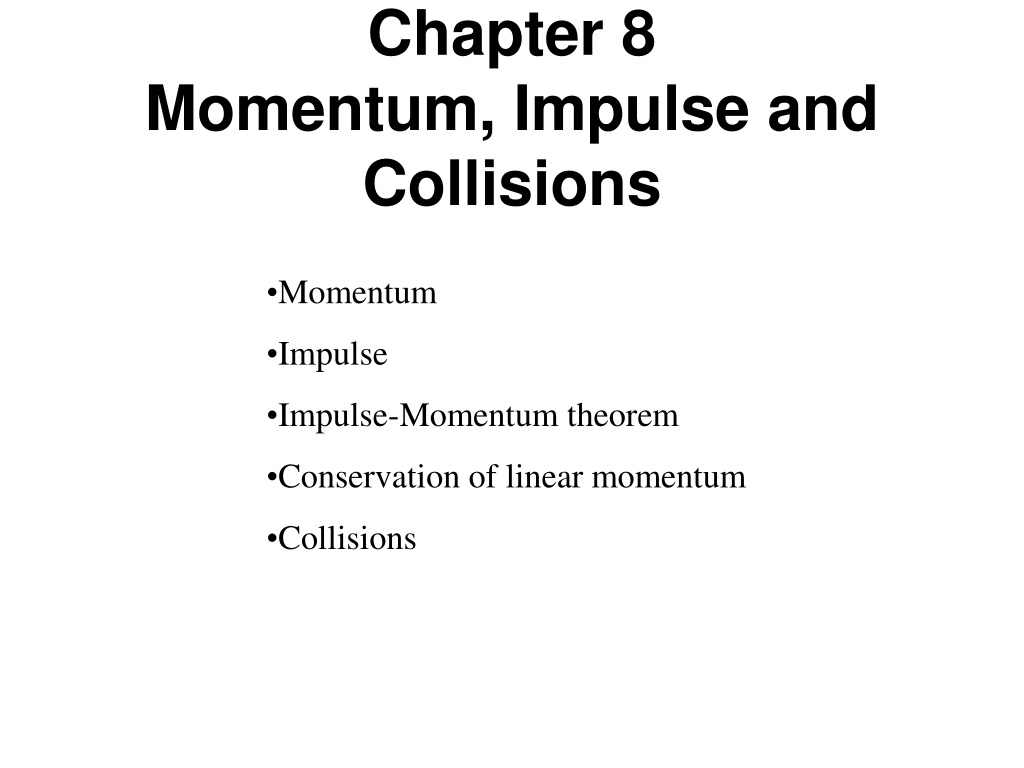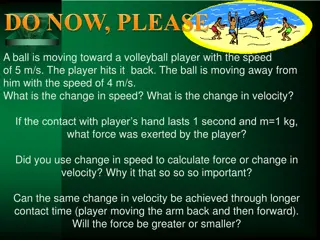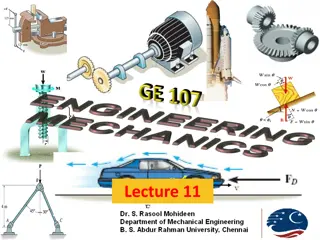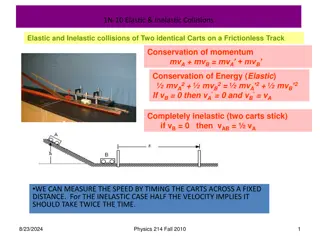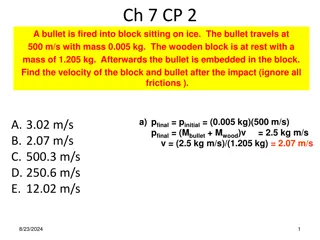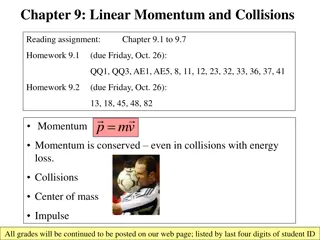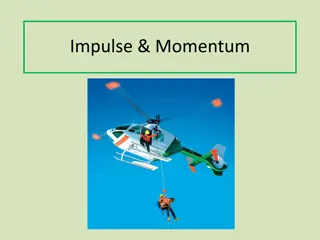Understanding Momentum, Impulse, and Collisions in Physics
Learn about momentum, impulse, and collisions in Chapter 8 of physics. Understand how linear momentum, impulse, and the Impulse-Momentum theorem are crucial in analyzing collisions and conservation of momentum. Explore real-world applications in sports and scenarios like a child driving a bumper car. Discover the relationship between force, impulse, and momentum through practical examples and concepts.
Uploaded on Sep 13, 2024 | 0 Views
Download Presentation

Please find below an Image/Link to download the presentation.
The content on the website is provided AS IS for your information and personal use only. It may not be sold, licensed, or shared on other websites without obtaining consent from the author. Download presentation by click this link. If you encounter any issues during the download, it is possible that the publisher has removed the file from their server.
E N D
Presentation Transcript
Chapter 8 Momentum, Impulse and Collisions Momentum Impulse Impulse-Momentum theorem Conservation of linear momentum Collisions
Momentum, p The linear momentum p of an object is the product of the object s mass m and velocity v: Linear momentum is a vector quantity that points in the same direction as the velocity. SI Unit of Linear Momentum: kilogram meter/second = (kg m/s)
Impulse, J The impulse J of a force is the product of the average force and the time interval t during which the force acts: Impulse is a vector quantity and has the same direction as the average force. SI Unit of Impulse: newton second = (N s) = kg. m/s Impulse and momentum, both have the same unit.
IMPULSEMOMENTUM THEOREM When a net force acts on an object, the impulse of the net force is equal to the change in momentum of the object:
11. Suppose a child drives a bumper car head on into the side rail, which exerts a force of 4000 N on the car for 0.200 s. (a) What impulse is imparted by this force? (b) Find the final velocity of the bumper car if its initial velocity was 2.80 m/s and the car plus driver have a mass of 200 kg. Neglect the friction between the car and floor.
Impulse and Momentum in Sports Impulse and momentum play important roles in sports.
Hitting a baseball Q: How can we determine the impulse? Method-1: Knowing the average force ( ) and contact time ( t), Impulse = F J = t Method-2: Impulse = Area under the Force versus Time graph.
Hailstones Versus Raindrops Unlike rain, hail usually does not come to rest after striking a surface. Instead, the hailstones bounce off the roof of the car. If hail fell instead of rain, would the force on the roof be smaller than, equal to, or greater? Answer: Greater
Example A baseball (m = 0.14 kg) has an initial velocity of v0 = 38 m/s as it approaches a bat. We have chosen the direction of approach as the negative direction. The bat applies an average force that is much larger than the weight of the ball, and the ball departs from the bat with a final velocity of vf = +38 m/s. Determine the impulse applied to the ball by the bat.
Definitions of Terms Internal forces Forces that the objects within the system exert on each other. External forces Forces exerted on the objects by agents that are external to the system. An isolated system is one for which the vector sum of the external forces acting on the system is zero.
7.2 The Principle of Conservation of Linear Momentum The total linear momentum of an isolated system remains constant (is conserved).
EXAMPLE Assembling a Freight Train A freight train is being assembled in a switching yard, and the Figure below shows two boxcars. Car 1 has a mass of m1 = 65 103 kg and moves at a velocity of v01 = +0.80 m/s. Car 2, with a mass of m2 = 92 103 kg and a velocity of v02 = +1.3 m/s, overtakes car 1 and couples to it. Neglecting friction, find the common velocity vf of the cars after they become coupled.
EXAMPLE: Ice Skaters Starting from rest, two skaters push off against each other on smooth level ice, where friction is negligible. As the Figure shows, one is a woman (m1 = 54 kg), and one is a man (m2 = 88 kg). Part b of the drawing shows that the woman moves away with a velocity of vf1 = +2.5 m/s. Find the recoil velocity vf2 of the man.
Collisions Collisions are often classified according to whether the total kinetic energy changes during the collision: 1.Elastic collision One in which the total kinetic energy of the system after the collision is equal to the total kinetic energy before the collision. 2.Inelastic collision One in which the total kinetic energy of the system is not the same before and after the collision; if the objects stick together after colliding, the collision is said to be completely inelastic.
Collisions in One Dimension 1. Apply the conservation of momentum. 2. If the collision is elastic, apply the conservation of energy.
Problem A car (mass = 1100 kg) is traveling at 32 m/s and collides head-on with a sport utility vehicle (mass = 2500 kg) traveling in the opposite direction. In the collision, the two vehicles come to a halt. At what speed was the sport utility vehicle traveling?
Football: 3rd Down During a 3rd down play with less than a yard to go, a Minnesota Viking player of mass 70-kg moving at 6 m/s was tackled head-on by a San Francisco 49er of mass 90-kg moving at 5 m/s. Predict the outcome of this play?
Car Collision Problem A car with a mass of 850-kg and a speed of 16 m/s approaches an intersection as shown. A 1200-kg minivan traveling at 21 m/s is heading for the same intersection. The car and minivan collide and stick together. Find the speed (vf) and direction ( ) of the wreckage just after the collision, assuming external forces can ignored.
